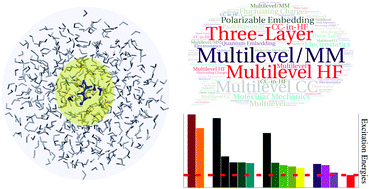Combining multilevel Hartree–Fock and multilevel coupled cluster approaches with molecular mechanics: a study of electronic excitations in solutions†
Abstract
We investigate the coupling of different quantum-embedding approaches with a third molecular-mechanics layer, which can be either polarizable or non-polarizable. In particular, such a coupling is discussed for the multilevel families of methods, in which the system is divided into an active and an inactive orbital space. The computational cost of the resulting three-layer approaches is reduced by treating the long-range interactions at the classical level. The developed methods are tested by the calculation of excitation energies of molecular systems in aqueous solution, for which an atomistic description of the environment is crucial to correctly reproduce the specific solute–solvent interactions, such as hydrogen bonding. In particular, we present the results obtained for three different moieties – acrolein, pyridine and para-nitroaniline – showing that an almost perfect agreement with experimental data can be achieved when the relevant physico-chemical interactions are included in the modeling of the condensed phase.



 Please wait while we load your content...
Please wait while we load your content...